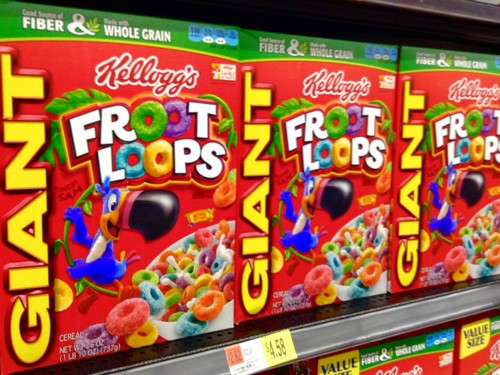- Marketing Mix Strategy ›
- Products ›
- Kellogg's Marketing Mix (4Ps) & Marketing Strategy
Kellogg's Marketing Mix (4Ps) & Marketing Strategy
Marketing strategy of Kellogg's through marketing mix framework which covers the 4Ps (Product, Price, Place, Promotion).
Kellogg's Product Strategy:
Kellogg’s has mulitple business segments which are based on product category or geography. Segments based on product catergory are US morning foods, US snacks. The products in the marketing mix of Kellogg’s covers breakfast cereals, as well as other foods items.
Cereals:
The US morning foods segment consists of products like cereal, toaster pastries, nutritional bars and beverages with prominent brands like Kellogg’s Cornflakes, Kellogg’s Chocos, Kellogg’s Frosties, Kellogg’s Coco-pops, Special-K, Kellogg’s Froot Loops etc. Breakfast cereal generates a revenue of more than $400 billion in sales globally each year and comprises majority of global sales.
Snacks:
The US snacks segment consists of cookies, crackers, savory snacks, cereal bars and fruit flavored snacks. Along with breakfast cereals, the brand also owns snacks brands like Eggo, Gardenburger, Pringles & Sunshine Biscuits. Snacks generate $200 billion globally in total sales each year and represent significant share of worldwide sales. Pringles is the largest brand in this category. New variants such as Pringles Tortillas have been introduced to increase sales. Kellogg’s emphasises on innovation launching a range of new products and variants such as Cheez-It Crunch'd, Kellogg's Raisin Bran with Cranberries, Eggo gluten free waffles. Kellogg’s is adapting its products according to consumer preference for healthier snacks with visible ingredients such as granola, fruits and nuts gluten-free Special K and Kashi sprouted grains and organic cereal.

Image: flickr-photos/jeepersmedia/
This concludes the product strategy in Kellogg's marketing mix & strategy.
Kellogg's Price/Pricing Strategy:
Below is the pricing strategy in Kellogg's marketing mix strategy:
Kellogg’s follows competitive pricing. Pricing is based on research and market conditions.
Kellogg’s regularly uses programs such as discounts and other schemes such as coupons which can be redeemed for free products. Kellogg’s keeps prices flexible to compete with other player and depending on sales growth. However, given their market leadership, the pricing strategy in the marketing mix of Kellogg's is often dominated by their own brands. As a part of its CSR initiative during the pandemic, the company donated cereals worth more than $10 million for fighting hunger globally.
Read more about Kellogg's
Kellogg's Place & Distribution Strategy:
Following is the distribution strategy in the Kellogg's marketing mix:
The largest 4 markets for cereals are U.S., Canada, U.K. and Australia. Kellogg’s is focusing on emerging markets. Kellogg’s has various distribution channels such as convenience, vending, mini superstores and high frequency stores. Kellogg’s sells its products through its direct sales force for resale by grocery stores. Kellogg’s also uses broker and distributor system for certain products. Kellogg’s markets some of its brands to supermarkets through a direct store-door delivery system. Kellogg’s is trying to make its products very easily available. Kellogg’s also has distribution through ecommerce.
Kellogg’s gets a large portion of its sales through stores like Walmart.
Kellogg's Promotion & Advertising Strategy:
The promotional and advertising strategy in the Kellogg's marketing mix is as follows:
Kellogg’s focuses on building a strong brand to increase sales. Kellogg’s uses various promotional strategies under its marketing mix. Kellogg’s has been the sponsor for USA gymnastics and kid’s series such as dragon tales. Kellogg’s uses prizes in cereal boxes as a promotional tool to target children. The brands have mascots which represent the brand and attract children. Kellogg’s has also sponsored motorsports events. Merchandising is another promotional tool. Kellogg’s released a PC game called Mission Nutrition with some special packs of cereal. Social media is being used for marketing campaigns. To increase snacks growth in emerging markets Kellogg’s has begun targeting brand messaging on special occasions and has expanded the availability of convenient cup and on-the-go packaging. This covers the entire Kellogg’s marketing mix.
About Kellogg's:
Kellogg's is a multinational food products company based in the United States. It is the largest cereal company in the world with sales of more than $14 billion. It is the second largest producer of cookies, savory snacks and crackers. The vision of the company is “To enrich and delight the world through foods and brands that matter”. Kellogg's produces cereal, crackers, pastries, bars, and other snacks with expertise in breakfast cereal. Kellogg's products are produced in 20 countries and are marketed in over 180 countries.
It employed more than 25000+ people. Kellogg’s has high level of competition from companies like General Mills, PepsiCo etc.
This article has been researched & authored by the Content & Research Team which comprises of MBA students, management professionals, and industry experts. It has been reviewed & published by the MBA Skool Team. The content on MBA Skool has been created for educational & academic purpose only.
Browse marketing strategy and 4Ps analysis of more brands similar to Kellogg's. The Marketing Mix & Strategy section covers 4Ps and 7Ps of more than 800 brands in 2 categories.
Continue Reading:
The names and other brand information used in the Marketing Mix & Strategy section are properties of their respective companies. The companies are not associated with MBA Skool in any way.
What is MBA Skool?About Us
MBA Skool is a Knowledge Resource for Management Students, Aspirants & Professionals.
Business Courses
Quizzes & Skills
Quizzes test your expertise in business and Skill tests evaluate your management traits
Related Content
All Business Sections
Write for Us